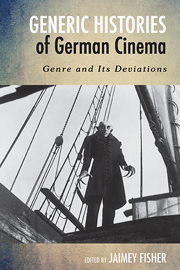Book contents
- Frontmatter
- Contents
- Acknowledgments
- Introduction: Toward Generic Histories—Film Genre, Genre Theory, and German Film Studies
- 1 Parallel Modernities: From Haunted Screen to Universal Horror
- 2 The Essay Film and Its German Variations
- 3 The Limits of Futurity: German Science-Fiction Film over the Course of Time
- 4 The Situation Is Hopeless, but Not Desperate: UFA's Early Sound Film Musicals
- 5 Resisting the War (Film): Wicki's “Masterpiece” Die Brücke and Its Generic Transformations
- 6 Ironizing Identity: The German Crime Genre and the Edgar Wallace Production Trend of the 1960s
- 7 From Siodmak to Schlingensief: The Return of History as Horror
- 8 Producing Adaptations: Bernd Eichinger, Christiane F., and German Film History
- 9 Exceptional Thrills: Genrification, Dr. Mabuse, and Das Experiment
- 10 The Heimat Film in the Twenty-First Century: Negotiating the New German Cinema to Return to Papas Kino
- 11 The Romantic Comedy and Its Other: Representations of Romance in German Cinema since 1990
- 12 Yearning for Genre: The Films of Dominik Graf
- Bibliography
- Notes on the Contributors
- Index
7 - From Siodmak to Schlingensief: The Return of History as Horror
Published online by Cambridge University Press: 05 December 2013
- Frontmatter
- Contents
- Acknowledgments
- Introduction: Toward Generic Histories—Film Genre, Genre Theory, and German Film Studies
- 1 Parallel Modernities: From Haunted Screen to Universal Horror
- 2 The Essay Film and Its German Variations
- 3 The Limits of Futurity: German Science-Fiction Film over the Course of Time
- 4 The Situation Is Hopeless, but Not Desperate: UFA's Early Sound Film Musicals
- 5 Resisting the War (Film): Wicki's “Masterpiece” Die Brücke and Its Generic Transformations
- 6 Ironizing Identity: The German Crime Genre and the Edgar Wallace Production Trend of the 1960s
- 7 From Siodmak to Schlingensief: The Return of History as Horror
- 8 Producing Adaptations: Bernd Eichinger, Christiane F., and German Film History
- 9 Exceptional Thrills: Genrification, Dr. Mabuse, and Das Experiment
- 10 The Heimat Film in the Twenty-First Century: Negotiating the New German Cinema to Return to Papas Kino
- 11 The Romantic Comedy and Its Other: Representations of Romance in German Cinema since 1990
- 12 Yearning for Genre: The Films of Dominik Graf
- Bibliography
- Notes on the Contributors
- Index
Summary
In 2002 Kino Video released a collection of “German Horror Classics.” This four-DVD set, boxed in a slick black case with Gothic lettering, includes Robert Wiene's Das Cabinet des Dr. Caligari (The Cabinet of Dr. Caligari, 1920), Paul Wegener's Der Golem und wie er in die Welt kam (The Golem and How He Came Into the World, 1920), Friedrich Murnau's Nosferatu: Eine Symphonie des Grauens (Nosferatu: A Symphony of Horror, 1922), and Paul Leni's Waxworks (1924). None of these films would have been considered “horror films” at the time of their release; nor, some would argue, should some of them rightly be considered horror films today. Nonetheless, these films are invariably cited as key entries in the horror-film lexicon. From Lotte Eisner's famous identification of German Expressionist cinema's “haunted screen” to contemporary transnational thrillers that export German history as horror film, German identity has consistently been represented through the lens of the Faustian soul, the haunted Teuton, the mad genius. It is therefore not surprising that film scholars typically cite Germany—“the land of dark forests and darker myths”—as the birthplace of horror. Carlos Clarens, in his definitive history of horror and science-fiction films prior to 1967, includes the first three films in his chapter on German film between 1913 and 1932, arguing that the sharp contrasts and dramatic acting of Expressionism offered precisely the right style “to render in black and white the reawakened fantasies of the darkly romantic German soul” (14).
- Type
- Chapter
- Information
- Generic Histories of German CinemaGenre and its Deviations, pp. 157 - 172Publisher: Boydell & BrewerPrint publication year: 2013



